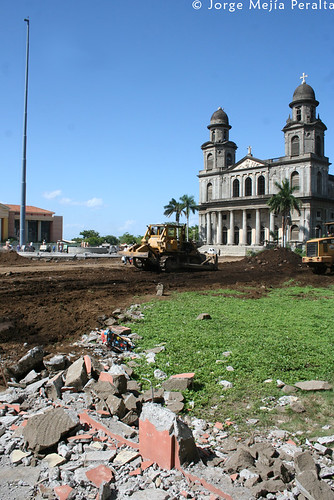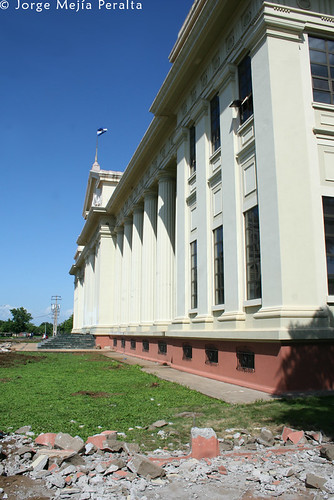Pictures by Jorge Mejia

View of the Plaza, with the Vieja Catedral.
Every city has a place which serves as a symbolic and historic center. In Managua, Nicaragua, the place that served as that space is/was the Plaza de la Republica, known as Plaza de la Revolución. Many historical events happened at this plaza, such as pro-Somoza activities, the triumph of the revolution in 1979, the national literacy campaigns in the 1980s, among other events.
In 1999, with Arnoldo Aleman as president (and after several murals dedicated to the revolution were erased by his government between 1990 and 1996) the government decided to rename the Plaza de la Revolucion to Plaza de la Republica, and build a musical water fountain at the center. The decision was criticized as an attempt to dismantle the symbols of the revolution of the 1980s.
On June 5th, with the Frente Sandinista de Liberación Nacional (FSLN) now back in power, the new government decided to restore the plaza to its original name and that the fountain must go. The media reactions were immediate.
However, there is also the opinion that the demolition of the fountain was just a smokescreen for covering two other bits of news.T he first one involved a group of investors being extortioned by the Nicaraguan consul Gerardo Miranda. The investors said the consul tried to bribe them at the FSLN's Secretaria (the official house of the party), which is also the residence and office of the Nicaraguan President. The previous presidential house is currently abandoned.
The case of Gerardo Miranda can be seen here, in spanish.
See the video about the Gerardo Miranda case in RealMedia (Video) by Esta Semana Esta Semana (This Week) is a investigative television program directed by Carlos Fernando Chamorro, who was the director of Barricada, a Nicaraguan newspaper in the 1980s.
The second piece of news that was said to be hidden by the plaza restoration was the international tour by President Daniel Ortega and his wife Rosario Murillo, which was sponsored by the government of Libya. The tour included stops in Venezuela, Libya, Iran, and Italy, but the last one was skipped at last moment. According to Nicaraguan law, the president must announce his visits to a foreign country, which is something that he didn't do.
On Television
Cana 2 of Nicaragua reported on June 8 about the fountain. See the video in YouTube. Local television stations have little or no power over their content that appears on YouTube.
President Ortega was in Libya at the moment of this newscast. To answer the criticisms, the first lady Rosario Murillo gave an interview to Nueva Radio Ya (website), which is a radio station closely linked to the government. Download the declarations of Rosario Murillo Download Here
Reactions in printed media (of many many others)
The two national newspapers dedicated headlines, opinion articles, and reports to this news. El Nuevo Diario: Historia no se quedó aparcada el 20 de julio (de 1979) (History that didn't stop on the July 20, 1979)
La Prensa: Alcalde Marenco reta a Murillo (Major Marenco challenges Murillo)
Dionisio Marenco, the mayor of Managua gave his thoughts on the matter, and the ironic thing is that he is a member of FSLN, the government's party, but he didn't support the measure.
La Prensa also reported:
El periodista cultural Wilmor López recordó que en el período edilicio de Arnoldo Alemán (1990-1996) , éste mandó a borrar “de un plumazo y sin contemplaciones” varios murales que fueron pintados por reconocidos artistas nicaragüenses.
Entre los murales considerados con gran valor artístico que fueron borrados por Alemán, López mencionó el mural de la biblioteca del Parque Luis Alfonso Velásquez, el mural del barrio Altagracia y las pinturas del artista Víctor Canifrú en la Avenida Bolívar.
“En ese entonces nadie reclamó porque ignoraron esa barbarie”, recordó López. Sin embargo Alemán niega que haya destruido obras culturales.
De acuerdo a López, lo que está haciendo el Gobierno de Ortega con la destrucción de la fuente, es la restitución de la plaza histórica de Managua.
The cultural journalist Wilmor López recalled that when Arnoldo Alemán was the mayor of Managua (1990-1996) , he ordered the removal of the many murals painted by renowned Nicaraguan painters.
Among the removed murals with great artistic value were the ones in Parque Luis Alfonso Velásquez's library in Altagracia, and the paintings of Victor Canifrú along Avenida Bolívar.
“Back then no one protested that savagery”, said López. However Alemán denied the destruction of any work of art.
According to López, what the goverment of Ortega is doing is restoring of the historical plaza of Managua.

Palacio de la Cultura, with the broken wall.
Radio La Primerisima (RealMedia audio)
Radio La Primerisima (web site) is a Sandinista radio station, but two of journalists (including the director of the radio, William Grisby) were in favor of the restoration of the Plaza, but against the way that it happened.
William Grisby: La Plaza de Managua: una decisión justa, un procedimiento equivocado. Los apodos de los capitalinos. (miércoles 6 junio)
Julio López Campos: Polémica sobre la recuperación de la Plaza de la República. (viernes 8 junio) (… The controversy on the restoration of Plaza de la República)
The forums
Nicaraguan web forums also discussed the fountain demolition.
Bacanalnica: Gobierno destruye fuente musical (Government destroys musical fountain)
Bacanalnica: Al rescate de la plaza de la revolución (To the rescue of the Plaza)
Rocknica: ** Destruyen fuente para reabrir Plaza de la República ** (Destroyed fountain to reinaugurate Plaza…)
SkycrapersCity: In memorian ” Fuente Musical “ Fotos de la fuente antes de la demolición. (Pictures of the musical fountain)
SkycrapersCity: Gobierno de ortega destruye fuente luminosa frente a Antigua Catedral Government destroys luminous fountain in front of cathedral.
In this post you can see how the Plaza looked before there were a fountain.

The works
The Blogs comment on the fountain
While the forums were participating in a more formal debate, the Nicaraguan blogs became creative with the theme.
Leonel Delgado published a short story written in 2000 [ES] about the Plaza (the fountain was built in 1999).
La Catedral y el Palacio Nacional (o de la Cultura) ya eran de por sí bastante feos. Con la añadidura de esa fuente y del Palacio Presidencial, todo adquiere un humor negro surreal y no es exagerado afirmar que se trata del lugar más claustrofóbico de Managua.
The Cathedral and the Palacio Nacional (or De la Cultura) were ugly enough already. With this fountain and the presidential palace, the entire place looks bleak
Gloria Ruiz wrote MALDITA [ES]
El Señor Presidente ve por la ventana. Tiene las manos entrelazadas. Ve la Capital, pero ve el pasado. Ahorita andan todos los chavalos alfabetizando. Estamos leyendo libros cubanos. La Chepa anda en la Alemania Socialista, estudiando pedagogía. Es feliz. Tiene su propia máquina del tiempo en su cabeza. Piensa con satisfacción en aquella victoria, y ve a la gente, a toda la gente, muchedumbre, multitud, aglomeración humana.
The Señor Presidente look out the window. His hands are crossed. He sees the Capital, but he looks at the past. All the boys are teaching others how to read and write. We are reading Cuban books. Chepa is in Socialist Germany, studying Pedagogy. He's happy. He has a time machine in his head. He daydreams of that old victory, and sees the people, all the people, commoners, the crowd, and humans.
Flickr set on the destruction of the fountain.

Podcast: Play in new window | Download
Subscribe: Apple Podcasts | Google Podcasts | RSS







2 comments
I thought this was an interesting article and this was discussed also on http://www.therealnicaragua.com
Let’s hope that Nicaragua can recover from its infighting.